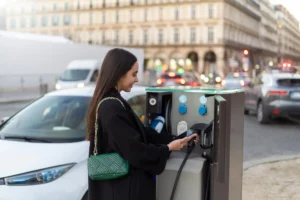
Home / EV Charging News / Electric Cars and Micro-Mobility Solutions: A Synergistic Evolution
The world of transportation is undergoing a profound transformation, with electric vehicles (EVs) at its core. While EVs have predominantly been associated with electric cars, their impact is extending beyond four-wheelers. This article explores the dynamic relationship between electric cars and the burgeoning world of micro-mobility, including electric scooters (e-scooters) and electric bikes (e-bikes).
Electric cars have emerged as a sustainable alternative to traditional gasoline-powered vehicles. Their rise is driven by a global commitment to reducing emissions and embracing cleaner modes of transportation. Electric cars are not only transforming the way we drive but also shaping the broader landscape of urban mobility.
In the quest for more sustainable and efficient urban transportation, micro-mobility solutions have gained prominence. This includes e-scooters, e-bikes, and similar compact electric vehicles designed for short trips within cities. These micro-mobility solutions have rapidly become a staple of urban transportation in many places around the world.
Electric cars have played a pivotal role in paving the way for the adoption of micro-mobility solutions. They have demonstrated the feasibility and advantages of electric propulsion, which has encouraged the development and acceptance of smaller electric vehicles for short-distance travel.
E-scooters have revolutionized the last-mile mobility segment. They are agile, lightweight, and ideal for short trips, especially in congested urban areas. These e-scooters are often available for rent through smartphone apps, providing convenient and eco-friendly transportation options.
E-bikes, on the other hand, offer a slightly different proposition. They are essentially bicycles with electric assistance, making pedaling easier and extending the range of a typical bike ride. E-bikes are well-suited for longer journeys within a city and are embraced by commuters seeking an efficient and eco-conscious mode of transportation.
The common thread connecting electric cars, e-scooters, and e-bikes is their commitment to reducing environmental impact. Collectively, they contribute to reduced emissions and improved air quality in urban areas. As the adoption of these electric modes of transportation increases, so does the potential for significant reductions in greenhouse gas emissions.
As electric cars, e-scooters, and e-bikes become more prevalent, the integration of these various forms of micro-mobility into urban transportation systems is crucial. This includes developing the necessary infrastructure, regulatory frameworks, and public awareness to ensure their safe and effective use.
The electric car revolution is extending its positive influence to the micro-mobility landscape, offering a glimpse of a cleaner, more efficient urban future. The adoption of e-scooters and e-bikes, along with electric cars, signifies a collective shift towards sustainable transportation. As these electric modes of transportation become more integrated into urban ecosystems, we must address the challenges of infrastructure development, regulation, and public awareness.
Ultimately, the synergy between electric cars and micro-mobility solutions not only reduces emissions but also enhances the quality of urban life. The convenience, eco-consciousness, and cost-effectiveness of these electric alternatives are propelling us towards a future where sustainable, interconnected modes of transportation are the norm.
As we continue to embrace electric vehicles and explore innovative micro-mobility options, we are forging a path towards greener, healthier, and more efficient cities where people and the environment can thrive in harmony.
